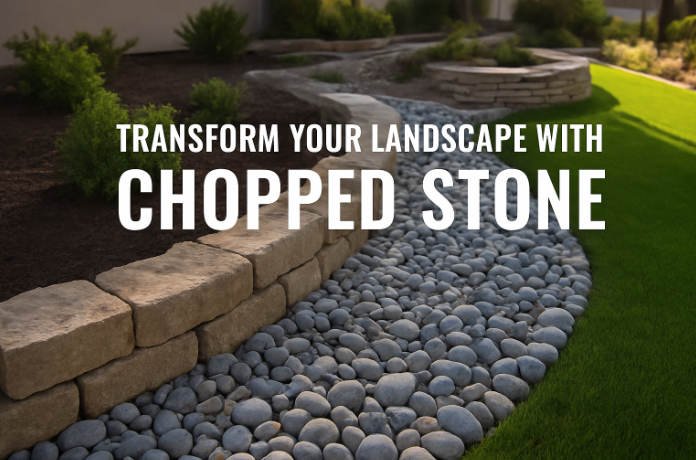When it comes to creating outdoor spaces that are both functional and elegant, Chopped Stone stands out as one of the most versatile materials available. From retaining walls and garden edging to decorative stone borders and pathways, this durable natural stone offers timeless beauty and strength suited for the challenging Texas climate.
If you’re looking to elevate your outdoor design, Chopped Stone can add structure, texture, and long-lasting appeal to your landscape. Here’s everything you need to know about using Chopped Stone to transform your DFW home or garden.
What Is Chopped Stone?
"Chopped stone" refers to rectangular or square-cut stones that have been mechanically split to consistent sizes while maintaining a natural edge. Available in various materials—such as limestone, sandstone, or flagstone—chopped stone blends natural charm with geometric precision.
These stones are ideal for DFW landscaping projects because they can handle the region’s intense heat, heavy rain, and occasional frost without losing their shape or color. Whether you prefer light, earthy tones or darker, rugged textures, Chopped Stone offers plenty of aesthetic options to suit any property style.
Benefits of Using Chopped Stone
1. Long-Lasting Durability
Chopped Stone withstands Texas weather conditions with ease. It’s resistant to cracking, fading, and erosion, making it perfect for both residential and commercial landscapes. Once installed, it requires minimal maintenance while maintaining its natural elegance for years.
2. Timeless Visual Appeal
With its natural texture and neutral tones, chopped stone adds sophistication to outdoor areas. Whether you’re aiming for a rustic farmhouse feel or a modern minimalist design, this stone complements almost any style.
3. Low Maintenance
Unlike wood or concrete, which can warp or chip over time, chopped stone holds up beautifully with little upkeep. Occasional cleaning and minor realignment are all that’s needed to keep your landscape looking fresh.
4. Eco-Friendly Material
Since it’s a natural product, Chopped Stone doesn’t contain synthetic additives or harmful chemicals. It’s an environmentally friendly option that supports sustainable landscaping.
5. Design Flexibility
Chopped stone can be used in many ways—garden edging, walkways, patios, retaining walls, and more. Its versatility allows homeowners and landscapers to experiment with textures, patterns, and levels for a truly custom outdoor design.
Popular Ways to Use Chopped Stone in Landscaping
1. Garden Edging
Chopped stone creates clean, structured edges between lawns, flower beds, and walkways. It keeps soil and mulch contained, defines borders, and enhances overall landscape symmetry.
2. Retaining Walls
For sloped areas, retaining walls built from chopped stone are both functional and decorative. They help prevent soil erosion while adding depth and structure to your yard.
3. Decorative Pathways
Combine Chopped Stone with gravel or decomposed granite to create beautiful garden paths. The mix of materials provides visual contrast and improves drainage in heavy rainfall areas like DFW.
4. Raised Flower Beds
Building raised beds with chopped stone gives your plants better soil drainage and adds a neat, organized look to your garden.
5. Outdoor Living Spaces
Chopped Stone can be used for outdoor fireplaces, seating walls, and kitchen surrounds. Its rustic texture and natural color variation make it ideal for creating cozy gathering areas.
6. Stone Borders
Installing Chopped Stone stone borders around driveways, trees, or garden beds adds definition and elegance. It’s a small upgrade that makes a big difference in curb appeal.
Tips for Working with Chopped Stone
-
Plan ahead: Sketch your design and calculate how much material you need.
-
Prepare the foundation: Use compacted gravel or sand to provide a stable base.
-
Use the right mix of sizes: Alternate larger and smaller stones for a natural look.
-
Check alignment frequently: Keep edges level and consistent during installation.
-
Seal optional: Applying a stone sealant can deepen color and enhance weather resistance.
Why Chopped Stone Works Best in DFW Landscaping
North Texas soil and weather patterns require materials that can endure extreme conditions. Chopped stone is dense enough to withstand temperature swings and heavy moisture without cracking. Its natural drainage properties make it ideal for DFW landscaping, especially in areas prone to clay soil and pooling water.
Moreover, it’s easy to blend chopped stone with other landscaping stones like river rock, flagstone, or crushed granite to create layered, textural designs that are both practical and beautiful.
Design Inspiration
-
Modern Garden Border: Pair neutral-toned chopped stone with dark mulch and lush greenery for contrast.
-
Rustic Walkway: Combine chopped limestone with gravel to create a countryside-inspired garden path.
-
Backyard Retreat: Frame a patio or fire pit area using stone borders for a cozy yet sophisticated outdoor space.
-
Elegant Entryway: Use chopped stone edging along the driveway for a polished, timeless entrance.
Frequently Asked Questions (FAQs)
1. What is the difference between chopped stone and natural stone?
Chopped stone is a type of natural stone that has been cut or “chopped” into uniform shapes, making it easier to install while keeping a rustic look.
2. Is chopped stone suitable for garden edging?
Yes. It’s one of the most durable and visually appealing materials for creating neat, long-lasting garden edging.
3. Can chopped stone be used for driveways?
While possible, it’s best used for edging or decorative accents rather than full driveway surfaces due to its shape and size.
4. Does chopped stone require sealing?
Sealing is optional. It can enhance color and protect the stone from staining, but many prefer its natural, weathered finish.
5. What’s the best base for installing chopped stone?
A layer of compacted gravel or sand helps provide stability and drainage beneath the stones.
6. How do I maintain chopped stone landscaping?
Occasional rinsing and repositioning of loose stones are usually enough. For deep cleaning, use mild soap and water.
7. What colors does chopped stone come in?
Common colors include cream, tan, gray, and buff, but variations depend on the stone’s origin.
8. Can I mix chopped stone with other materials?
Absolutely. It pairs beautifully with gravel, decomposed granite, or mulch for a balanced and natural aesthetic.
9. Is chopped stone expensive?
It’s typically mid-range in price—more affordable than high-end stone veneers but more durable and elegant than wood or plastic edging.
10. How does chopped stone hold up in the DFW climate?
Exceptionally well. It resists expansion, cracking, and fading, making it ideal for DFW landscaping in both hot summers and wet winters.

